 Boats in Lampedusa harbour: two big boats from Libya and one from Tunisia in the middle. Source: Alarm Phone.
Boats in Lampedusa harbour: two big boats from Libya and one from Tunisia in the middle. Source: Alarm Phone.
Introduction
In the second half of 2021, Alarm Phone was alerted to 214 boats in the central Mediterranean region. Together with the 193 boats that Alarm Phone had supported in the first half of the year, in 2021 we assisted a total of 407 boats in distress in the central Mediterranean only. This is by far the highest number of distress cases reported to us in this region within a year. In 2019, Alarm Phone had assisted 101 cases. In 2020, we supported 173 distressed boats. This considerable increase in distress cases reflects both a significant increase of precarious crossings over the past years, as well as a greater knowledge of the Alarm Phone network among migrant communities.
Of the 407 boats we supported in 2021, 45 boats were rescued to Europe by the civil Search and Rescue fleet. Despite obstruction and harassment by state authorities, these civil rescuers have returned to sea, again and again, to carry out life-saving missions. As state authorities in both Europe and northern Africa often fail to inform of rescues or interceptions, we do not know exactly how many of the other boats that called Alarm Phone reached Europe or were returned to Libya or Tunisia. However, in the monthly breakdown below, we provide further information on how many boats we believe have arrived in Europe or were returned to northern Africa.
In 2021, Alarm Phone also had to witness the shipwrecks of several boats that reached out to us, with hundreds of people losing their lives. While official statistics speak of about 1550 deaths in the central Mediterranean Sea in 2021, we know that this is a significant undercount, as many shipwrecks reported to us by friends or families of the missing were never officially accounted for. We will never know how many lives were lost at sea in 2021. We only know that they are always too many.
Over the year, we had to also witness how groups of people escaping Libya and Tunisia were systematically abducted at sea and forced back into conditions where their human rights are severely violated. More than 32,400 people were intercepted by the EU-funded so-called Libyan coastguard – the number almost tripled compared to 2020. EU authorities have not merely funded, trained, and politically legitimised the Libyan forces, they also continue to cooperate closely with them to organise boat interceptions and refoulements. While EU authorities fail to adequately coordinate Search and Rescue operations to Europe, routinely engaging in acts of non-assistance and push-back, they are also actively supporting the mass interceptions by Libyan and Tunisian authorities, not least through aerial surveillance operations. Since 2021 a Frontex drone has been active above the Central Mediterranean sea, in addition to several airplanes spotting migrant boats heading to Europe, reporting them to Libyan authorities, and facilitating their pushbacks.
Despite high level of push backs to the places of departure, the countless violations of human rights in detention, violence and exploitation, people on the move keep searching and finding ways to flee Libya, Tunisia, Turkey or Greece to European shores.
Resistance against the constant violence and rising surveillance against people on the move does not only lead to find alternative paths to Europe, by changing routes or by travelling on different kind of boats, but also culminated in collective self-organisation by refugees in Libya who, since October 2021, have organised powerful protests in front of the UNHCR in Tripoli.
In this report, we provide an overview of several acts of resistance and we offer a chronology of events that occurred in the second half of 2021. We do so to create an archive of the struggles that have occurred in the central Mediterranean Sea, which are often ignored or silenced by state authorities. Besides the stubborn and continuous struggles of people on the move, we have seen how the civil fleet, together with airborne divisions of NGOs and the Alarm Phone, have shed light on developments that EU authorities do not want the public to see. By writing down this chronology, we add to our growing archive of the struggles at sea and the resistance to the violent EU border regime both by people on the move and by those who support them.
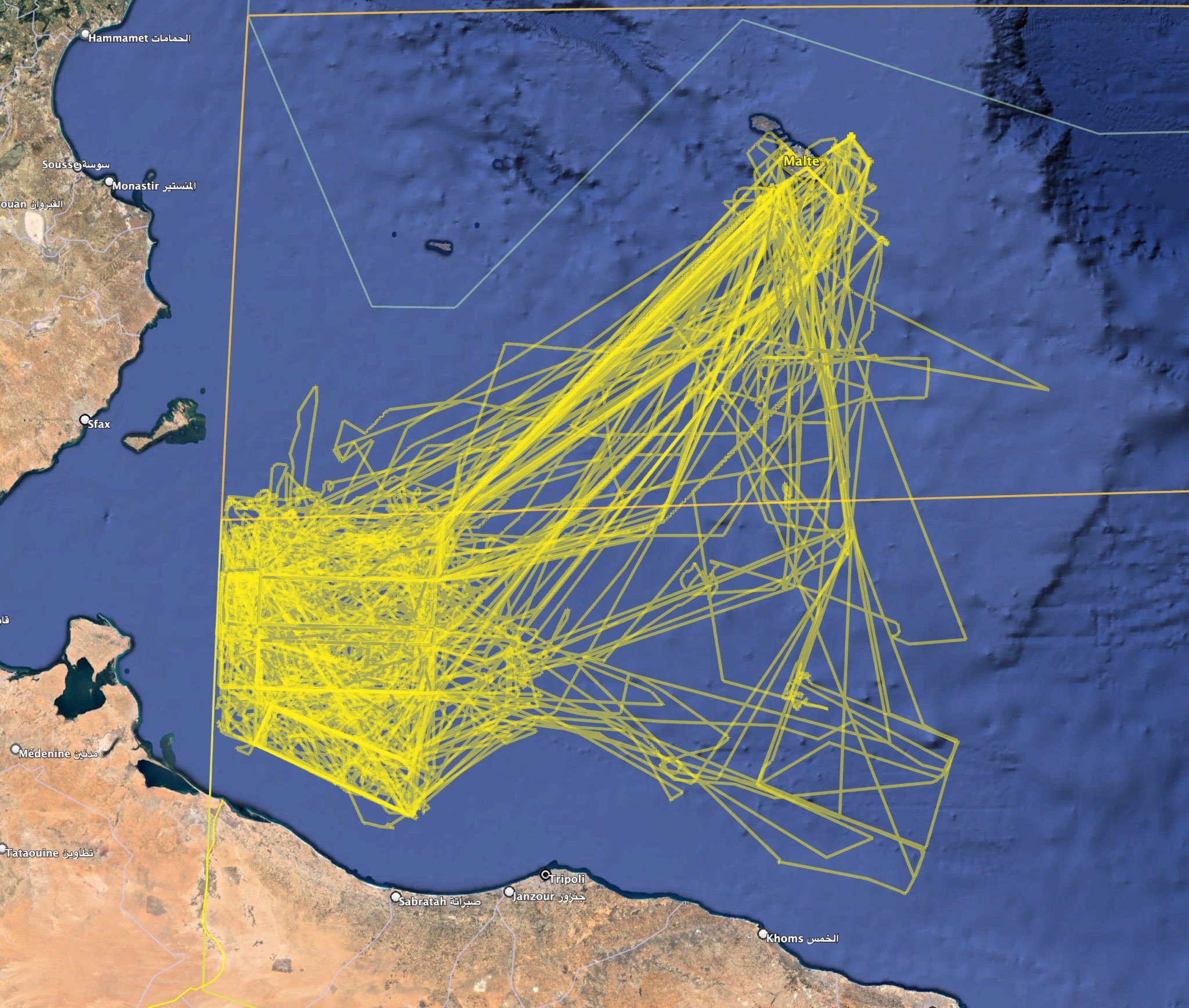 Overlay of daily tracks of the Frontex drone 1 June to 31 July 2021. Source: adsb-exchange, analysed by Le Monde
Overlay of daily tracks of the Frontex drone 1 June to 31 July 2021. Source: adsb-exchange, analysed by Le Monde
Frontex: Pushbacks from the sky
Since May 2021 Frontex is flying a drone in addition to the existing assets surveilling the sea off Libya and Tunisia to spot migrants boats. The drone is leased from Airbus company and is flying every day for several hours, starting from Malta airport. During that time, the runaway is closed for civil flights. Unnamed, the Frontex drone is able to carry more fuel, and to operate additional surveillance equipment, which means a prolonged flight time and more time to spot migrant boats on their way to Europe.
With its introduction, the surveillance area in the Central Med has been enlarged: the Libyan coast, as well as the north and south of Tunisia are hyper-surveilled. Frontex is alerting the coast guards, routinely leading to illegal pushbacks to Libya. In 2021 32,400 interceptions by the so-called Libyan Coastguard were reported, assumingly many with the help of Frontex air surveillance.
The cooperation between Frontex and the so-called Libyan Coastguard – which is still officially denied – is documented by several news outlets. Frontex shares information about boats on the move not only via official emails but via direct messages on Whats App. Investigations show that Frontex assets focus on the area of international waters south of the Maltese SAR Zone – in the so-called Libyan Search and Rescue zone -which clearly shows that the interest is less in preventing tragedies but rather in actively producing them. People in distress at sea often tell us on the phone that they saw airplanes. Many of them also tell us that they made two, three or many more attempts to flee Libya in vain – being always forced back by the so-called Libyan Coastguard.
We were informed of about 42 shipwrecks off Libya and Tunisia in 2021 alone. Many of them happened close to the shores of Libya. When lives are in danger, the so called Libyan Coastguard rarely helps, but arrives late if at all. As Alarm Phone, we also experienced how they claimed to send a vessel, which then never appeared on scene: people in distress were left to die.
In our daily work we often witness that the so-called Libyan Coastguard is present only to intercept boats and force people back to Libya. They prove that their mandate is to prevent people from reaching Europe, rather than rescuing people in distress. In many cases we even witnessed how vessels of the so-called Libyan Coastguard closely follow and shadow rescue vessels of the civil fleet, in order to intercept boats before civil rescue can reach them.
With this, we don’t demand the so-called Libyan Coastguard to get better equipped or educated by the EU-member states and EUNAVFOR MED Operation Irini. Instead, we demand the defunding and abolition of the so-called Libyan Coastguard.
Besides the so-called Libyan Coastguard, also other actors are involved in intercepting migrant boats and bringing them back by force to Libya: The Coastal Security off Zuwara and the Stability Support Apparatus (SSA), who becomes more and more powerful and only little public information about their operations is available.
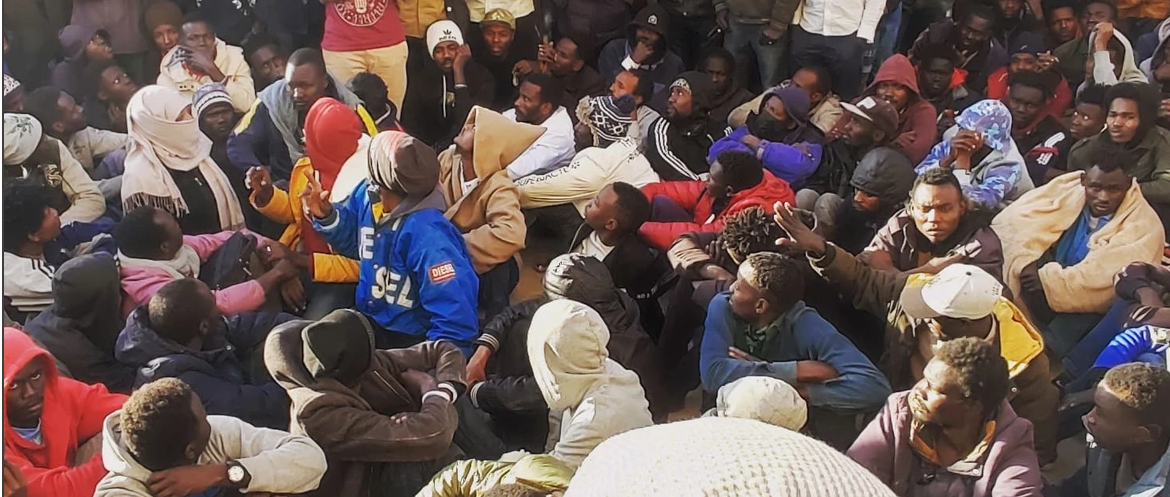 Protest in front of UNHCR Tripoli. Source: www.refugeesinlibya.org
Protest in front of UNHCR Tripoli. Source: www.refugeesinlibya.org
Refugee protests in Tripoli
On 1st october 2021, Libyan security forces and affiliated militias violently broke into the Gargaresh area (West Tripoli), where thousand of refugees were living in extremely poor conditions. During these ‘raids’, beatings, extreme violence, sexual abuses, and killings were reported by both survivors and NGOs. While the official reason – or better ‘excuse’, provided by the ministry of interior, was that of carrying out a ‘anti drug and crime operation’, most of the 5,000 arrested people were moved to the detention and return center Al Mabani (Ghout Al Shaal area), showing how the real aim of this brutal operation was that of pushing people back to circuit of violence, extortion and detention as well as of possible illegal deportations to countries of origin.
After these events, 4,000 people managed to escape from detention, and between 3,000 and 4,000 of them started a sit-in in front of UNHCR Community Day Centre in Tripoli. Protection from violence, evacuations, resettlement were their main demands, as well as the interruption of EU cooperation with Libya, aimed at preventing people from fleeing the country. The protests lasted three months, until the sit in was forcibly evicted. For the first time, migrant protesters in Libya managed to reached out to a global solidarity network to amplify their voices, by using social media to documented their conditions in first person, and to narrate their struggles in real-time via Twitter, Facebook and their blog Refugees in Libya.
These tools helped them to speak out loudly against the systemic violence of border regimes, including the lack of freedom of movement and capacity to escape Libya, the hypocrisy of international organisations like the UNHCR and IOM, the daily exposure to ill treatments, detention, deportation and death. The responsibility of the European Union, as the main funder of the Mediterranean border regime, and of UN organisations as a “facade” of human rights respect, were at the heart of the refugees’ discourse. They clearly asked the EU to stop funding and equipping the so called Libyan Coastguard, to stop fostering the circuit of violence made of detention, interceptions at sea and detention again.
During the three months of protests, three refugees lost their lives.
Nevertheless,the mainstream narrative attempted to delegitimize these protests, by labelling them as violent, and people’s demands and requests as illegitimate. The sit-in eviction was a last attempt of criminalizing and silencing refugee voices claiming rights, counternarrating, documenting and speaking out against the violent border regime.
We will continue to stand by their side!
More on their Website: https://www.refugeesinlibya.org/manifesto
and Twitter account: https://twitter.com/RefugeesinLibya
Central Mediterranean routes: Algeria, Ionian Sea and Tunisia.
Besides the Libya route, the Alarm Phone is active also on other routes in the Central Mediterranean, including Algeria to Sardinia, the Ionian Sea, and Tunisia to Italy.
Algerian route: from Algeria to Sardinia
In 2021, we received an unprecedented number of calls from boats departing Algeria and trying to reach Italy. During the second half of 2021, we tried to assist several boats departed from East Algeria – such as Annaba or Skikda – with the intention to reach Italy via Sardinia. According to the UNHCR data, in 2021 1,549 people reached Italy by sea through the Algerian routes (2% of the total), against the 1,391 (4% of the total) people who made it in 2020. The vast majority of them is of Algerian nationality, while a minority are Syrians. Generally we are alerted by several relatives, or community members, living on both shores of the Mediterranean Sea. They call us desperately looking for information about their loved ones, who departed days earlier from Algerian shores. They share names, dates and places of birth, as well as pictures, asking us to find information on arrivals which could reassure them about the fate of their missing loved ones As for the other central mediterranean routes, boats travelling from Algeria to Sardegna are often unseaworthy – sometimes old fishing boats or fiberglass boats – carrying between 10 to 20 people, including women and children.
As for the Tunisian route to Italy, people who travel along the Algerian route to Italy don’t have a satellite phone, and their orientation equipment consists of a simple compass. Over the past years, we realized that the coastguards could locate normal phone numbers of people at sea, but apparently only when are in national waters, or after a recent call. For this reason, we usually manage to collect as much phone numbers as possible, to enhance the Coastguards’ chances to find them.
At the end of 2021, consistently with what already observed in the Western Med routes from Algeria to Spain, we noticed the presence of Syrian refugees amongst those leaving East Algeria to reach Sardinia. Syrian refugees’ presence in Algeria dates back to the beginning of 2013. At that time, they chose Algeria as a transit country to Morocco, where they could pay border officials to cross to the enclaves and try to seek asylum. After the closure of Maghenia border between Algeria and Morocco they have been obliged to reach Morocco via the south – crossing Mauritania and Senegal – while many of them remained stuck in Algeria.
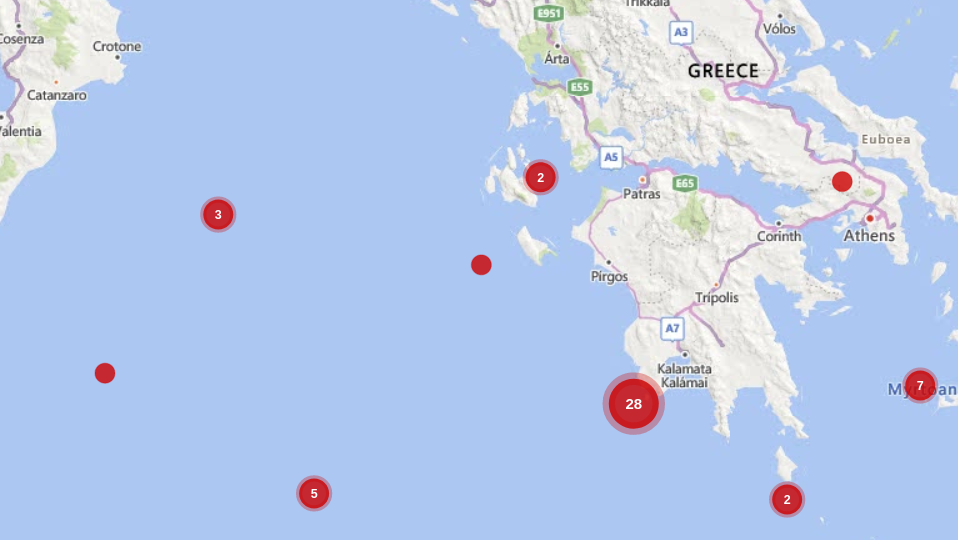 Ionian sea with concentration of distress cases who alerted Alarm Phone. Source: watchthemed.net
Ionian sea with concentration of distress cases who alerted Alarm Phone. Source: watchthemed.net
The Revival of the Ionian Route
In 2021 the arrivals in Calabria increased like in other places of Italy, more than 11,600 people were registered in Calabria in 2021 according to UNHCR. Among them mostly people from Iran and Iraq who departed from Turkey and Greece.
Due to the common violent push backs in the Aegean Sea and the Evros region, people decide now for this longer route through the Ionian Sea, which is far more dangerous. The “Ionian route” therefore became vivid again. Around Christmas alone, Alarm Phone was in contact with survivors of four shipwrecks. These shipwrecks happened still far from Italy and the Ionian sea, close to islands of Paros, Folegandros and Antikythera as well as Crete.
Since the beginning of June 2021 Alarm Phone was alerted to 27 boats in distress on this route, which were heading from Turkey to Italy. Luckily, several boats made it to Italy, but there were also many boats that were brought to Greece after distress situations. The Alarm Phone also documented in the past long-distance push backs from this region into Turkish waters by the Hellenic Coast Guard. The following examples explain some remarkable context about the developments along this route.
On September 23, the Alarm Phone was informed about 154 people on a boat in distress in the Ionian Sea in direction to Italy. The GPS position we received showed the group in international waters on the Greek Search and Rescue zone. The Alarm Phone immediately alarmed the responsible authorities. The Hellenic Coast Guard ordered an oil tanker to rescue the people, who then were brought to Paleochora in Crete. Reportedly, one woman died during the rescue operation and three people were arrested for boat driving. The survivors of the incident first had to stay 14 days in quarantine in Chania and afterwards were moved to mainland Greece where they got imprisoned in the notorious Amygdaleza prison near Athens.
On the 24th of October we were informed about a boat with 45 people in distress 42km inside the Italian Search and Rescue Zone and we informed Italian authorities about the alert. At 00:40 CEST, MRCC Reggio Calabria informed us that all 45 people are on board the cargo vessel Grande Italia (IMO: 9227912) heading to Greece. Finally, the people were brought to Kalamata. Even though we tried, we could not find out further details, why the people have been pushed back to Greece, instead of being brought to Italy, their actual destination.
In the evening of the 20th of November we were alerted to a boat in distress close to Crete, with 70 people on board of a white yacht. At 21:30 CET we informed the Hellenic Coast Guard in Piraeus about the situation and asked them to launch a rescue operation. Even though we repeatedly updated the Hellenic Coast Guard about the worsening situation on board, no rescue was launched until the next morning. In the morning, the sinking boat was reportedly hit by a vessel. Only when people started to fall into the water, they were rescued. One man died in this act of non-assistance. Again, the survivors did not receive any appropriate support, but on November 27th, they were transferred to the Amygdaleza prison near Athens.
In sum, the Alarm Phone repeatedly witnessed several particularities on this route: on the one hand, the Hellenic Coast Guard often ordered merchant vessels or ferries to reach the distress-location and to conduct the rescue. While the Hellenic Coast Guard seems to have sufficient assets at sea to conduct pushbacks, this seems not to be the case in severe distress situations along the Ionian route.
Beside that, people are systematically imprisoned after deportation to Greece. Also the survivors of the Christmas shipwrecks were imprisoned in Amygdaleza for nearly two months. In addition to that, there is a severe criminalization of boat drivers: according to information received, two or more passengers of each boat are accused of alleged smuggling and fear immense prison sentences. On the contrary, often local solidarity groups and networks became active in the past months to shed light on the responsibility of the Greek authorities or to support the travellers.
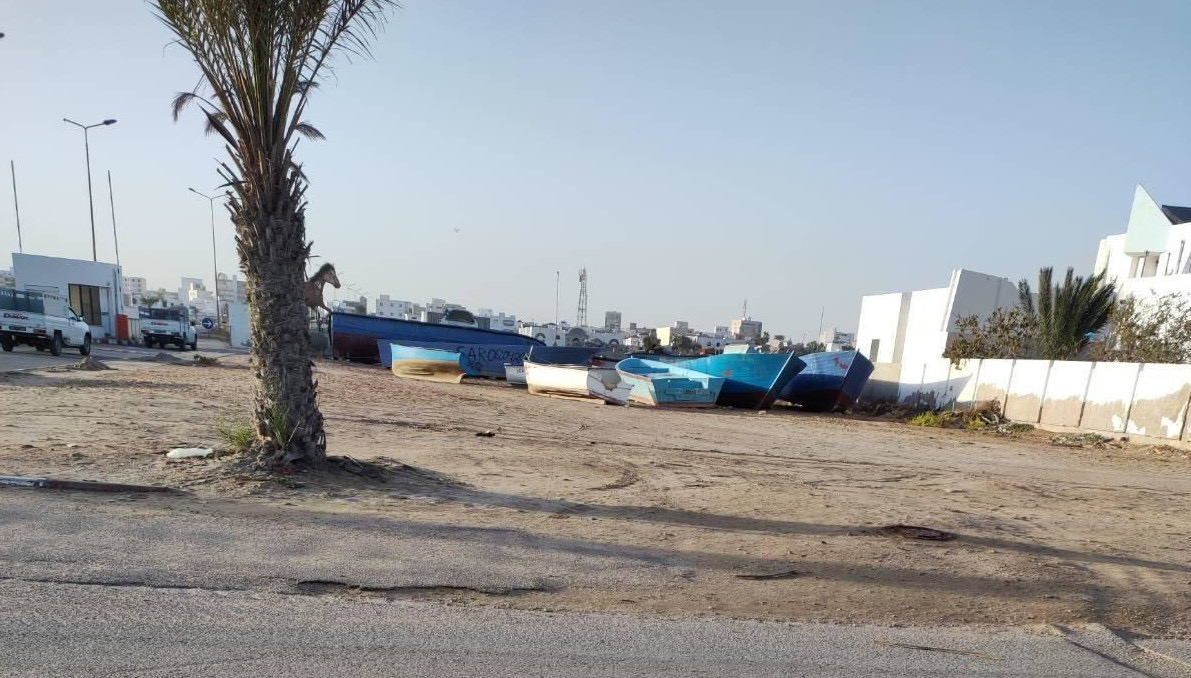 Intercepted boats in Zarzis harbour. Source: Alarm Phone
Intercepted boats in Zarzis harbour. Source: Alarm Phone
Tunisia: A more “effective” Watchdog on the external Borders of the EU
In 2021, The Tunisian authorities have intercepted 25,657 people who were trying to reach Europe. According to the Tunisian NGO FTDES, the number of people who were prevented to arrive to Europe during the year 2021 represents more than 61% of the total of those prevented during ten years (2011-2020), in line with the ongoing borders militarization approach.
Also the Alarm Phone has witnessed that more interceptions are being carried out by the Tunisian Coast Guards and Navy, affecting boats departing from the Libyan coasts. Several boats usually encounter an engine problem or fuel shortage when they are in the Maltese Search And Rescue zone; due to the non-assistance of the Maltese authorities, the boats remain adrift for hours and therefore get intercepted by the Tunisian Authorities.
Although the direct involvement of Frontex is still denied, the Tunisian Ministry of Defense clearly admits that there is a “cooperation” between Tunisia, Italy and Malta.
At least 1500 people that have departed from the Libyan coasts were intercepted by the Tunisian Navy alone in the second half of 2021. These interceptions were almost non-existent in the last years, but despite the opposition of the different tunisians governments to implement the “disembarkation platforms” on its territories since 2018, the current situation indicates an indirect plan to implement the “Regional Disembarkation Platform”.
The people who have been intercepted are brought to one of the ports located in the south-east of Tunisia, where UN agencies such as UNHCR, IOM and their partners are present to “filter” people who are eligible for international protection based on their nationality only.
People do not have access to individual interviews and do not have knowledge about their rights, such as the right to seek asylum. Many are usually left with the only option, guaranteed by the IOM, of accepting the so-called voluntary return.
In 2021 we witnessed the “effectiveness” of the Tunisian Government and of the UN institutions in implementing the outsourced sorting of people on the move, at the service of the EU and with the support of the ICMDP.
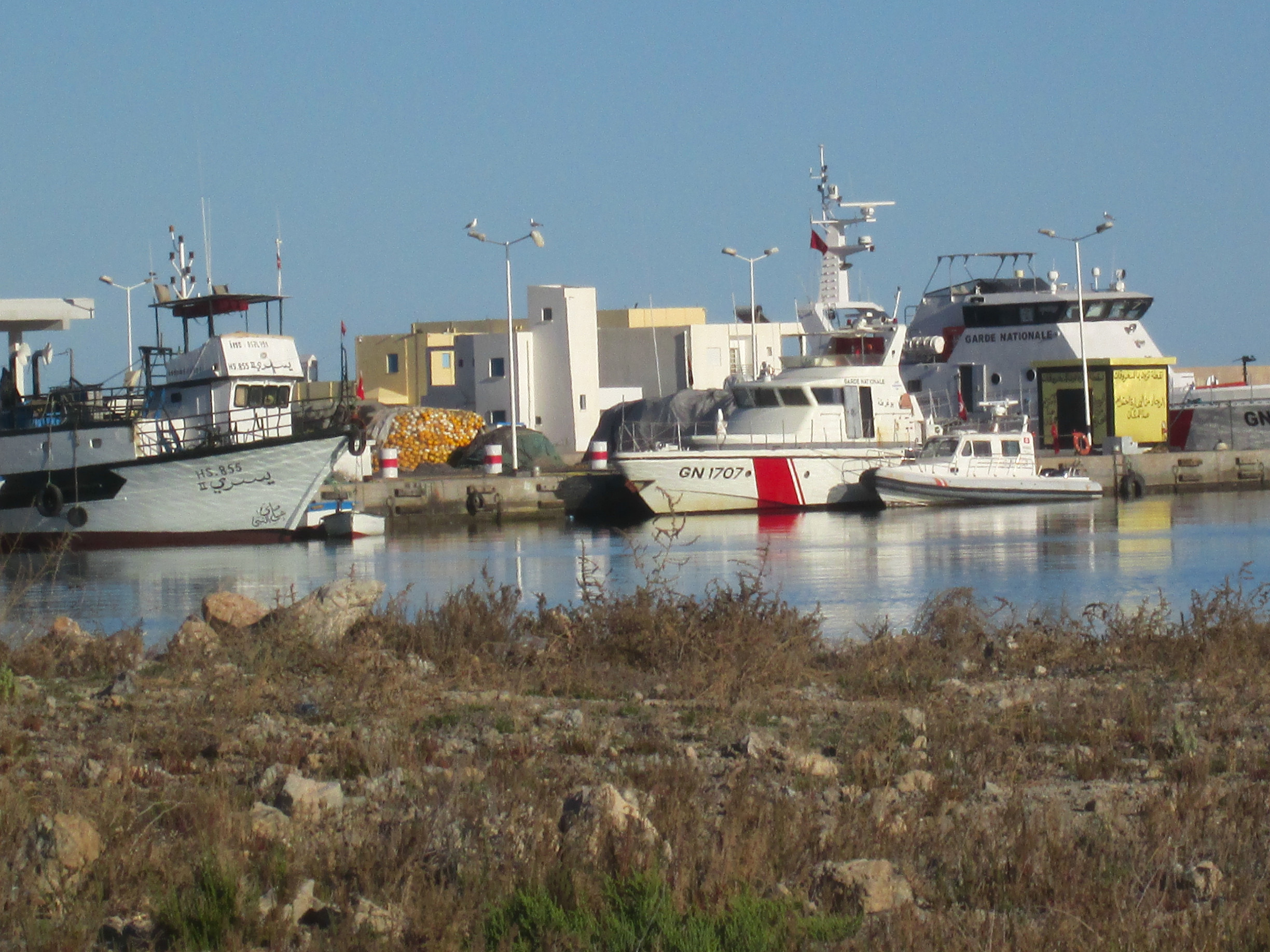 Tunisian Coast Guard in Zarzis port. Source: Alarm Phone
Tunisian Coast Guard in Zarzis port. Source: Alarm Phone
Tunisian navy attacks migrant boat
On the 10th of July 2021, a boat with 65 people departed from Sfax, Tunisia. In order to protect European borders, the Tunisian Navy attempted to sink the boat with dangerous maneuvers. Of the 65 people on board, only 31 people survived. This is not the first time that such a behavior is witnessed. Different people, whether arriving to Italy or after getting intercepted to Tunisia, have reported that dangerous maneuvers were carried out by the Tunisian authorities.
Below a testimony from one of the survivors.
“It was 5:00 in the morning, few hours after we left from Sfax, we were very close to the international waters (30 minutes acc. to the GPS position). The Tunisian Coast Guard approached our boat and asked us to stop. We decided to obey and the captain stopped the engine. But the Tunisian Coast Guard made a very quick U-turn and crashed deliberately into our boat. Our boat capsized. Everybody fell into the water. Some of us had life vests but not everyone. Many could not swim and drowned. The Tunisians (5 men) took the survivors on their vessel. We were only 31 survivors. All the children died. They also took 7 bodies on their vessels. While we were heading to Sfax, we were so furious that we wanted to kidnap one of the coastguards. But they understood what our plan was and when we arrived at the port (at around 10:00 in the morning), they ran away. Some friends came to the port to help us to disembark the bodies. Other authorities came and took the bodies to the morgue. We were looking for the Tunisian Coast Guard to show them our pain and anger but the port was empty. It was like they realized what they did and they decided to disappear.
We did not have any assistance at the port. We met the Red Cross in Sfax who told us that 8 more bodies had been found, but that we could not see them because of COVID… We did not get any psychological support whereas many of us are getting crazy. I am with a woman who lost her child. She is crazy. We are not afraid of anything anymore. They can make us problems, we do not care, we are ready to die. We lost everything.”
Chronology July – December 2021
July
In July, the Alarm Phone was alerted to 41 boats in distress in the Central Mediterranean. Of them, at least 10 were intercepted by the so-called Libyan coastguard, five by the Tunisian authorities. We know of at least 15 further interceptions of boats that had not reached out to Alarm Phone. Of the boats we were in contact with, six were rescued by NGOs (Ocean Viking and Sea Watch 3). Eight boats made it to Lampedusa, one to Sicily, three were rescued to Malta and one to Tunisia. For several of the boats that contacted us, we have no confirmation of their fate. We know of six shipwrecks in July, not Alarm Phone cases, leading to at least 142 deaths and 65 people going missing.
On 1 July, public pressure hindered RCC Malta from successfully coordinating an illegal pushback together with the so-called Libyan Coastguard. A boat with about 50 people on board was – deep inside the Maltese Search and Rescue (SAR) zone and they reported shots to us by the so-called Libyan Coastguard who aimed to stop them. They were finally rescued to Lampedusa. The EU Commission later stated that it would launch an investigation into this incident, and media reports covered this case as well.
The same day, the Ocean Viking performed two rescues in Malta SAR and was disturbed by a Libyan patrol boat.
On 2 July, media reports spoke of a shipwreck off Sfax/Tunisia. Eight bodies were recovered and 46 people rescued. On 3 July, we heard of two other shipwrecks, one near Zawya, the other one of a boat from Zuwarah that capsized off Zarzis.
Also on 2 July, the MSF ship Geo Barents was detained and was the third NGO vessel in detention at that time while several others were also hindered from operating.
On 2 and 3 July, the so-called Libyan Coastguard intercepted almost 250 people, on 4 July another 186 and on 5 July another 90 people, who had alerted Alarm Phone. In the period of 4-10 July, 326 people were returned to Libya, according to IOM.
On 4 July, the Ocean Viking – after saving four boats in distress – performed a fifth rescue. One of these boats had alerted Alarm Phone from Malta SAR. During the night to 5 July, 369 people were safely evacuated by the Ocean Viking from a large wooden boat.
On 7 July, a boat with almost 500 people on board arrived in Lampedusa.
The same day, 49 people stranded on an oil field in international waters. The Tunisian Coastguard brought them to Tunisia, which is no safe place.
On 12 July, a shipwreck off Sfax was reported, 8 bodies were found and 49 survivors brought to Tunisia.
On 13 July, Alarm Phone was called by 81 people who fled Libya and were adrift in Malta SAR. After many hours in distress, they were finally rescued to Malta. Three people were found dead.
The week 12-18 July was characterized by bad weather with strong north winds and high waves, not many boats left and the sailing vessel Nadir withdrew from the area.
On 21 July, about 100 people in severe distress called Alarm Phone from Maltese SAR, but only after many hours a white and red boat headed toward them. Although authorities have not confirmed this to us, we believe that they were later brought to Lampedusa.
 Map with the position of the boat that called us on 21 July from Maltese SAR. Source: Alarm Phone
Map with the position of the boat that called us on 21 July from Maltese SAR. Source: Alarm Phone
Also on 21 July, at least 20 migrants drowned off Libya and more than 500 others were intercepted and returned to Libya. They were all detained. In the night, another shipwreck off the Tunisian coast claimed at least 17 lives, 168 people were rescued.
On 22 July, patrol boat 648 of the so-called Libyan coastguard, which three weeks before had fired shots at a wooden boat, intercepted people in Maltese SAR. Further boats were intercepted on 23 and 24 July.
On 25 July, about 50 people at sea called Alarm Phone. They had left Khoms and were in distress in Maltese SAR – eventually they were rescued by the Armed Forces of Malta.
On 26 July, another shipwreck was reported, which claimed at least 57 lives after a boat capsized near Khoms.
On 27 July, the so-called Libyan Coastguard threatened the crew of Sea Watch 3 to arrest them in international waters, falsely claiming they had such authority in the so-called Libyan SAR zone.
On 28 July, the rescue of a boat which called us in Maltese SAR was confirmed by relatives and the media.
On 30 July, about 120 people, among them a pregnant woman and people with bullet wounds were abducted by the so-called Libyan Coastguard. In the period of 25-31 July, 1,111 migrants were intercepted and returned to Libya.
August
August was a very busy month for Alarm Phone and the civil fleet. We were alerted by 46 boats, most of them coming from Libya, ten from Tunisia and three from Greece trying to reach Italy. At least ten of these 46 boats were intercepted, seven of them forced back to Libya, three to Tunisia. Two boats returned to Tunisia independently themselves. Six of the 46 boats were rescued by NGOs (one each by Sea Watch 3 and Ocean Viking; three by Geo Barents, including one where the sailing boat Nadir had assisted; two by ResqPeople, the former Alan Kurdi). Of 13 boats we know that they made it to Lampedusa, two to Malta, two boats from Greece arrived in Sicily. Especially for boats coming from Tunisia, we often do not know if they were among the many arrivals in Lampedusa. Two of the boats which had called us shipwrecked, One of them, where one person died and five people went missing, was a boat from Libya, the other one had left from Tunisia and 34 people died. In total, we know of 63 deaths and 39 people going missing during this month.
On 1 August, Seabird and Sea Watch 3 observed an interception of a boat by the so-called Libyan Coastguard in Maltese SAR. More than 1,000 migrants were intercepted by Libyan entities that day and the day before.
Also on 1 August, Alarm Phone was alerted by almost 400 people on a large wooden multi-deck boat adrift in international waters. In a five hour long rescue operation, supported also by Nadir, the people were transferred to the Sea Watch 3 and to the Ocean Viking. The same day, Seabird found another completely overcrowded wooden boat with about 300 people on board and passed the coordinates to Italy and Malta.
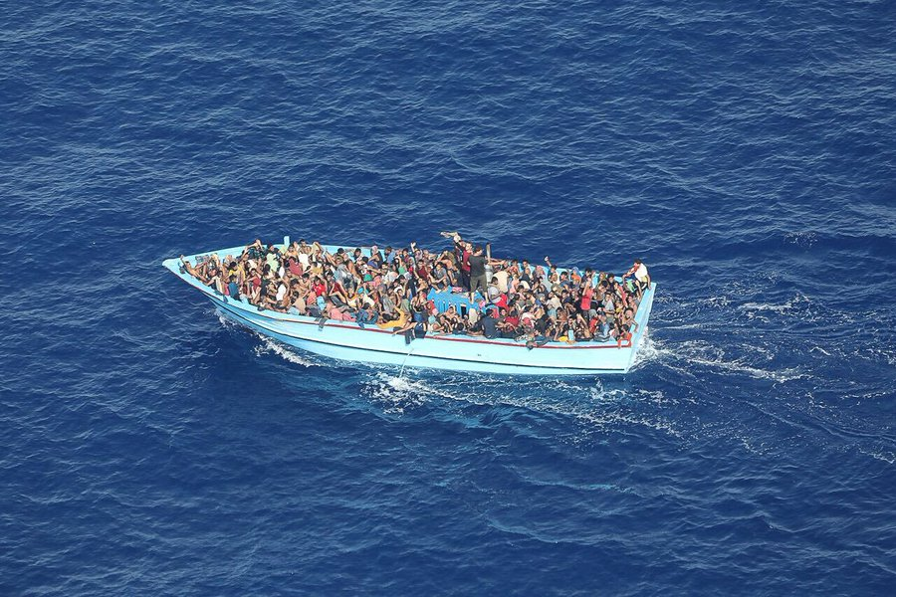 The boat with about 300 people found by Seabird. Source: David Lohmueller/ Sea-Watch
The boat with about 300 people found by Seabird. Source: David Lohmueller/ Sea-Watch
On 2 August, Alarm Phone was called by three other boats adrift in Maltese SAR with about 400 people at risk. The Sea Watch 3 had to send maydays for them and stay on standby until, eventually, the Italian Coastguard rescued the people.
On 3 August, a group of 41 asylum seekers, who had called Alarm Phone, was rescued by the Armed Forces of Malta.
On 5 August, about 25 people in Maltese SAR alerted Alarm Phone and were found by Nadir and finally rescued by Geo Barents.
On 6 August, 140 people in distress called us off the coast of Italy and were later rescued by the Italian Coastguard. The same day, Sea Watch 3 was assigned a Port of Safety in Trapani.
On 8 August, the Ocean Viking disembarked 549 survivors in Pozzallo. The same day, Zuwara fishermen, jointly with Libyan Coastal Security, found 50 migrants in distress and recovered two bodies from a capsized boat. 48 people went missing.
On 11 August, we learned about another shipwreck off Tunisia – 29 dead bodies were found.
On 15, 16 and 17 August, the Geo Barents rescued several boats, among them 189 people who had alerted Alarm Phone.
On 18 August, eight people who called Alarm Phone from a leaking boat in Maltese SAR were finally rescued to Malta.
On 22 August, the Nadir provided first aid to 22 people in distress in Maltese SAR, until the Italian Coastguard sent an asset to take them on board.
On 23 August, we heard about two sailing boats which were rescued to Crotone/Italy. But there were also two deadly incidents, one off the Libyan coast with at least 17 deaths, another one near the island of Levanzo/Italy, where 22 migrants were rescued, one found dead.
Between 23 and 25 August, many interceptions to Libya took place. During one of them, a dead body was recovered and 14 people were reported missing.
On 24 August, a boat with about 25 people, among them many children, one of them disabled, who had called us, was able to reach Lampedusa.
On 27 August, Seabird spotted a capsized boat in international waters. 11 people climbed back onto the overturned boat while five people were in the water. After a mayday relay, it took hours until the Italian Coastguard ordered the Asso Venticinque to rescue the people.
On 28 August, a boat with 550 people on board arrived in Lampedusa.
On 31 August, Alarm Phone was alerted by a boat carrying nine people, including three children, off Tobruk/Libya. We lost contact and the Egyptian authorities told us that the so-called Libyan Coastguard had searched for them in vain.
September
In September, Alarm Phone was alerted to 26 boats in distress, most of them off Libya, two coming from Algeria and an increasing number from Tunisia (six) and Turkey (three). Five of these boats were intercepted and forced back to Libya, three to Tunisia, and one to Turkey. One boat was rescued by a merchant vessel to Greece. Two of these boats were rescued by NGOs, one by the Ocean Viking, one by the Geo Barents, who also rescued several other boats. Concerning four of the boats which had called us, we know that they reached Lampedusa, as did many boats that had not reached out to us. One of the boats from Turkey reached Italy while the fate of the other boats is unclear. We heard about two shipwrecks, one off Lampedusa and one off Sfax.
On 1 September, the Sea Eye 4 rescued 29 people, among them two heavily pregnant women, in a severe distress situation, just in time before the weather worsened.
On 2 September, we learned of a shipwreck off Nabeul/Tunisia. 20 people were rescued from a sunken rubber boat.
On 6 September, Alarm Phone was alerted to 9 people on a wooden boat travelling from Annaba/Algeria to Sardegna. The Algerian Coastguard searched for them in vain, the Italian authorities refused to give information.
On 9 September, the Italian Coastguard rescued 125 people from a tiny uninhabited island near Lampedusa.
On 10 September, about 60 people drifting more than 24 hours off Chebba/Tunisia called Alarm Phone. We alerted coastguards and they were rescued by the Tunisian authorities, as was a second boat in distress nearby.
On 12 September, the Geo Barents, together with the Italian Coastguard, rescued about 40 people from a sailing boat in Italian SAR zone.
On 14 September, fishermen in Zarzis/Tunisia protested against the armed threats and piracy operations carried out by the so-called Libyan Coastguard inside Tunisian territorial waters.
On 16 September, Alarm Phone was in contact with about 45 people in Maltese SAR, moving slowly due to engine problems. We assume that they were rescued by the Italian Coastguard, but state actors did not share information.
The same day, Maersk Etienne’s crew received a special recognition by the IMO for the rescue of 27 people one year earlier, highlighting the importance of merchant vessels in SAR operations.
On 17 September, we learned that more than 800 migrants were intercepted and returned to Libya during that week. The same day, Alarm Phone took part in a powerful CommemorAction in Palermo to remember people killed by the EU border regime.
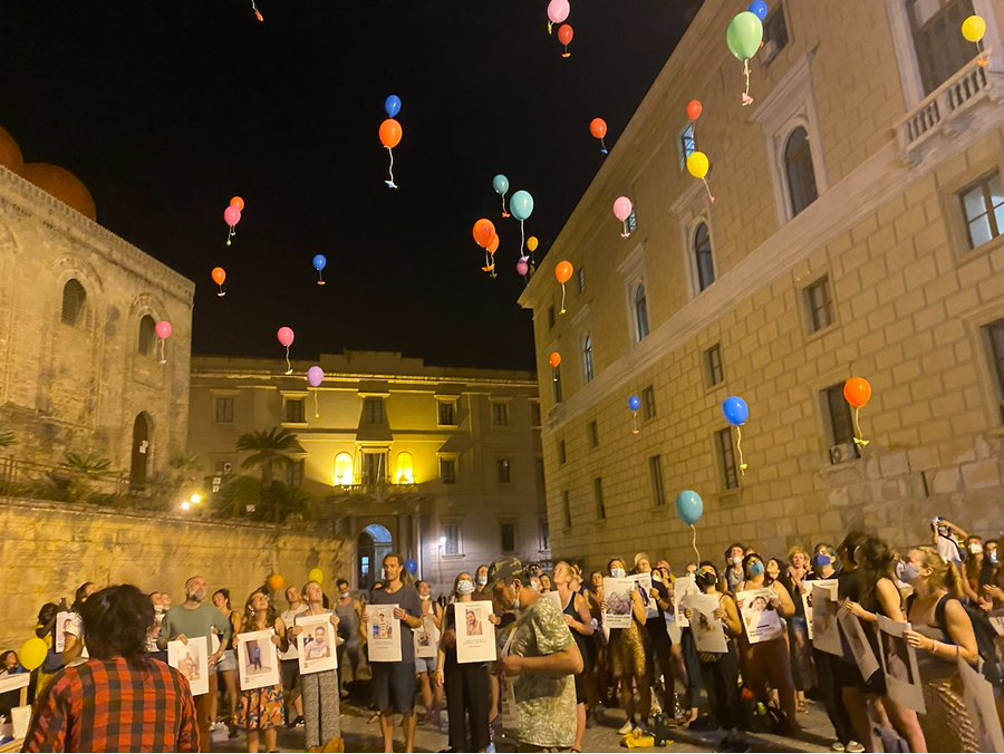 CommemorAction on 17 September in Palermo. Source: Alarm Phone
CommemorAction on 17 September in Palermo. Source: Alarm Phone
On 18 and 19 September, the Ocean Viking, in one case supported by the Nadir, rescued several boats. On 20 September, also the Geo Barents rescued two boats. Also on 20 September, Alarm Phone was alerted by about 55 people in distress in the Ionian Sea. Authorities did not answer, but we found information in media reports that confirmed their rescue to Italy.
On 23 September, Alarm Phone was informed about another 130 people on a boat with a broken engine in the Ionian Sea, but still in the Greek SAR zone. One day later we heard from relatives that they had been rescued by an oil tanker and brought to Crete. Reportedly, one woman died during the transport to the tanker.
On 26 September, Alarm Phone was alerted to nine people from Algeria who tried to reach Sardegna. Two days later, we were informed to three further boats from Algeria and alerted authorities. We know that some people were rescued, but did not receive full confirmation.
On 27 September, about 100 people were stopped by the Tunisian Coastguard off Sfax.
The same day, Alarm Phone was alerted by about 70 people in a rubber boat south of Malta. We lost contact to them and authorities did not provide any information.
In the night from 27 to 28 September, over 800 migrants landed on Lampedusa, among them 686 people aboard an old fishing boat.
On 29 September, Alarm Phone was alerted to a large boat in distress 20km south of Lampedusa. We hope that they reached the island. A journalist reported about 101 arrivals of the same nationalities during the night.
On 30 September, we received only bad news: 91 people were forced back to Libya after spending two days at sea on a rubber boat. Also, Domenico „Mimmo“ Lucano, a mayor who welcomed migrants to the Italian town of Riace, was sentenced to 13 years in prison. On the same day, a fire destroyed a self-organized camp in Campobello/Sicily. 50 migrants blocked the road and demanded decent accommodation.
October
In October, Alarm Phone was alerted to 31 boats in distress. 28 of them left from Libya, one from Tunisia and two from Turkey toward Italy. Seven of these boats were intercepted by the so-called Libyan Coastguard, one boat returned to Libya independently. We know of at least 15 more interceptions. Eight of the boats we were in contact with were rescued by NGOs (five by Sea Watch 3, three by Geo Barents), which also rescued several further boats in distress. One boat was rescued by an Italian supply ship. Seven of the boats reached Lampedusa, one arrived in Malta. One of the boats from Turkey reached Calabria, the other one was brought to Greece by a cargo ship. One of the boats from Libya shipwrecked, leaving 15 people dead. We learned about other shipwrecks in which 68 people went missing and 48 people died. For several of the other boats that had alerted Alarm Phone, we have no confirmation of their fate.
On 1 October, about 4,000 migrants were arrested in a crackdown in the Libyan town of Gargaresh and taken to detention in Tripoli. They were detained in the Al-Mabani Gathering and Return Center, where people are abused and extorted for ransom. The United Nations said one migrant was killed and at least 15 others injured when Libyan security authorities carried out the raids. The Interior Ministry described it as a security campaign against undocumented migration and drug trafficking, but made no mention of any traffickers or smugglers being arrested.
On 2 October, the Alarm Phone was alerted to 70 people on a boat from Khoms that had been missing for four days. Authorities refused not only to rescue but also to provide any information on their fate.
Another boat with about 70 people, who called us the same day, was rescued by the Italian supply ship Asso29.
On 3 October, we learned of a boat with 89 people on board. Later, two bodies were retrieved and 40 people went missing, Survivors were brought to Tripoli, together with about 500 other people who were intercepted and forced back to Libya.
On 5 October, the Alarm Phone was alerted by 31 people in danger near the Bouri oil platform. Later we learned that they were intercepted by the so-called Libyan Coastguard despite two merchant vessels being nearby for hours.
On 6 October, the sailing vessel Nadir sighted a wooden boat and had to take the 39 people on board, because coastguards failed to react.
On 7 October, the Aita Mari was blocked by authorities on administrative orders.
On 8 October, thousands of migrants who had been arrested in Gargaresh escaped from prison. Five migrants were shot dead by the authorities while they were hunting these people. Later it was discovered that 34 people were shot dead and 350 people wounded.
On 11 October, about 105 people in danger off Zuwara called Alarm Phone. The boat capsized and the so-called Libyan Coastguard was not able to recover all people alive. 15 people had suffocated on the boat while waiting for rescue.
On 13 October, the Alarm Phone was alerted by 97 people, adrift 30km from Kerkennah island/Tunisia, but without a GPS position. We urged authorities to search for them.
On October 14, we learned that 23 migrants had been rescued by a Tunisian fisherman from a sunken boat north of Zarzis. The same day, there was an important court decision in Naples: The captain of the Italian ship Asso 28 was convicted for returning migrants to Libya in 2018.
On 17 October, the Sea Watch 3 rescued two boats in distress, one of them had alerted Alarm Phone. The same day, we learned of another shipwreck off Tunisia. Seven people were rescued, two bodies found and 22 people went missing.
On 18 October, Alarm Phone was in contact with about 75 people in a rubber boat in distress off Garabuli/Libya. We lost contact, Italy denied responsibility, and the so-called Libyan Coastguard did not find them. Two other boats which called Alarm Phone were rescued by Sea Watch 3, two others were intercepted. The Nadir also rescued 34 people.
On 20 October, the prosecutor of Agrigento asked the judge for the complete acquittal of the commander of the ship Mare Jonio for the rescue operation on 9 May 2019. Mediterranea Saving Humans wrote on this decision: “Rescue at sea cannot be criminalised; it is an obligation”.
On 21 October, the Alarm Phone was in contact with 27 people off the coast of Calabria. We hope that they were rescued to Italy as authorities refused to confirm their rescue.
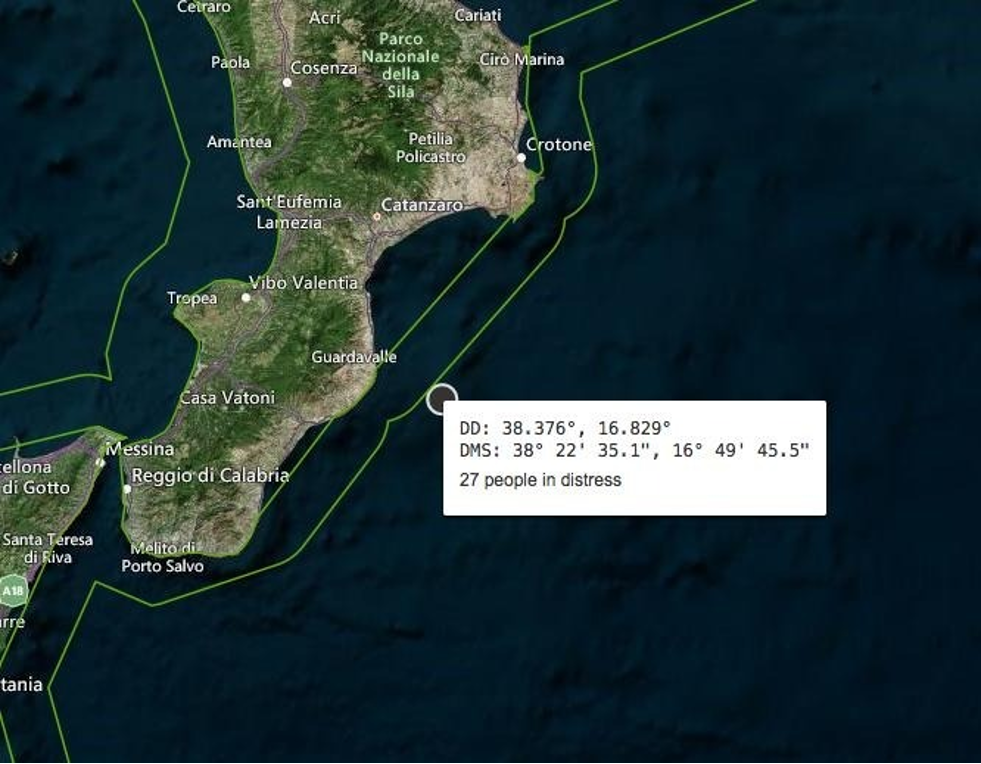 Map with the position of the boat that called us on 21 October. Source: Alarm Phone
Map with the position of the boat that called us on 21 October. Source: Alarm Phone
The same day, we learned about a shipwreck off Tunisia. Of 30 people on board, four people died and 21 went missing.
On 22 and 23 October, the Geo Barents rescued several boats in rough weather and prevented an interception of 95 people by the so-called Libyan Coastguard. However, at least three interceptions took place, among them a boat which had called the Alarm Phone.
At a sit-in in front of the UNHCR center in Tripoli, thousands of migrants launched a collective protest campaign, calling for evacuation from Libya in the wake of sweeping raids that saw thousands arrested.
On 24 October, about 68 people drifting just 14nm south of the Italian SAR zone alerted Alarm Phone. Frontex monitored the boat from air for five hours, but authorities refused to provide information. Nonetheless we assume that they were rescued to Lampedusa.
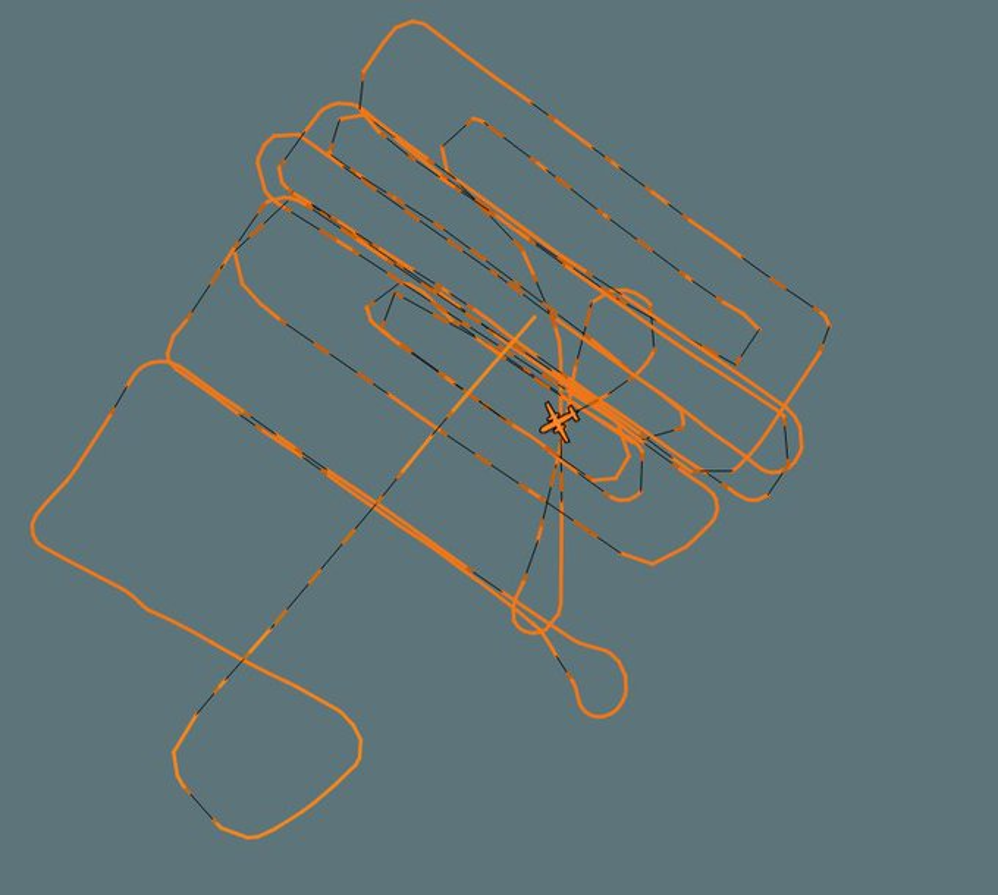 Track of Frontex flight on 24 October. Source: Alarm Phone
Track of Frontex flight on 24 October. Source: Alarm Phone
The same day, 60 people in a deflating boat called the Alarm Phone in extremely bad weather conditions. We alerted authorities and the Geo Barents, which could later rescue the people.
On 25 October, we were informed by Italian authorities that 45 people in a sailing boat who alerted the Alarm Phone from the Italian SAR zone between Greece and Italy were rescued by a cargo ship heading to Greece.
The same day, we learned from the Italian Coastguard that they had rescued a fishing boat with 339 migrants on board off the Calabrian coast.
On 27 October, a weather warning was published for the following days with a cyclone in the Channel of Sicily. We did not hear from boats leaving from Libya until the end of the month.
On 28 October, the protesting refugees in Libya laid out their suffering and political demands in an online press conference.
On 28 October, Sea Watch reported that 1,016 people had been rescued by civil rescue ships in October and more than 1,800 fleeing people arrived independently in Lampedusa.
On 31 October, the crew of the SeaEye and of the RiseAbove witnessed the interception of 27 people by the so-called Libyan Coastguard.
November
November was a very busy month for the Alarm Phone and the civil fleet. 41 boats alerted Alarm Phone from Libya, three from Tunisia and two from the Ionian Sea. At least 10 of these boats were intercepted to Libya, three to Tunisia and one of the Ionian cases was a pushback to Turkey. 13 boats were rescued by five different NGO vessels. At least 10 boats made it to Lampedusa, one was rescued to Calabria. The outcome of most of the other cases is unclear. We learned about one shipwreck, probably there were more, because dead bodies were found ashore. According to official sources, 41 people died and 65 went missing. Survivors of a shipwreck told us that about 75 people had died.
On 2 November, the Ocean Viking rescued 94 people of an overcrowded boat who had alerted Alarm Phone. The same day, media sources reported about 49 migrants who had been rescued from cliffs on the Maltese coast.
On 3 November, 85 people who fled from Libya and called Alarm Phone, were rescued by the merchant vessel Vos Apollo and brought to Tunisia, which is not a place of safety.
On 4 November, a boat carrying about 400 people, who called us in distress the day before, was rescued by the SeaEye and the Rise Above, as authorities refused to intervene.
During the first four days of November, Alarm Phone was busy with nine cases in the Central Mediterranean, seven (carrying about 900 people) were rescued by the civil fleet, one by the Italian Coastguard.
On 5 November, evacuation flights from Libya to Niger started again after one year pause.
On 6 November, the Nadir reached the last known position of about 30 people who had alerted Alarm Phone the day before on an abandoned oil platform.
The same day, the Alarm Phone was informed about 14 people in distress who had fled Libya from Benghazi five days earlier. Eventually, they were rescued by the Italian Coastguard.
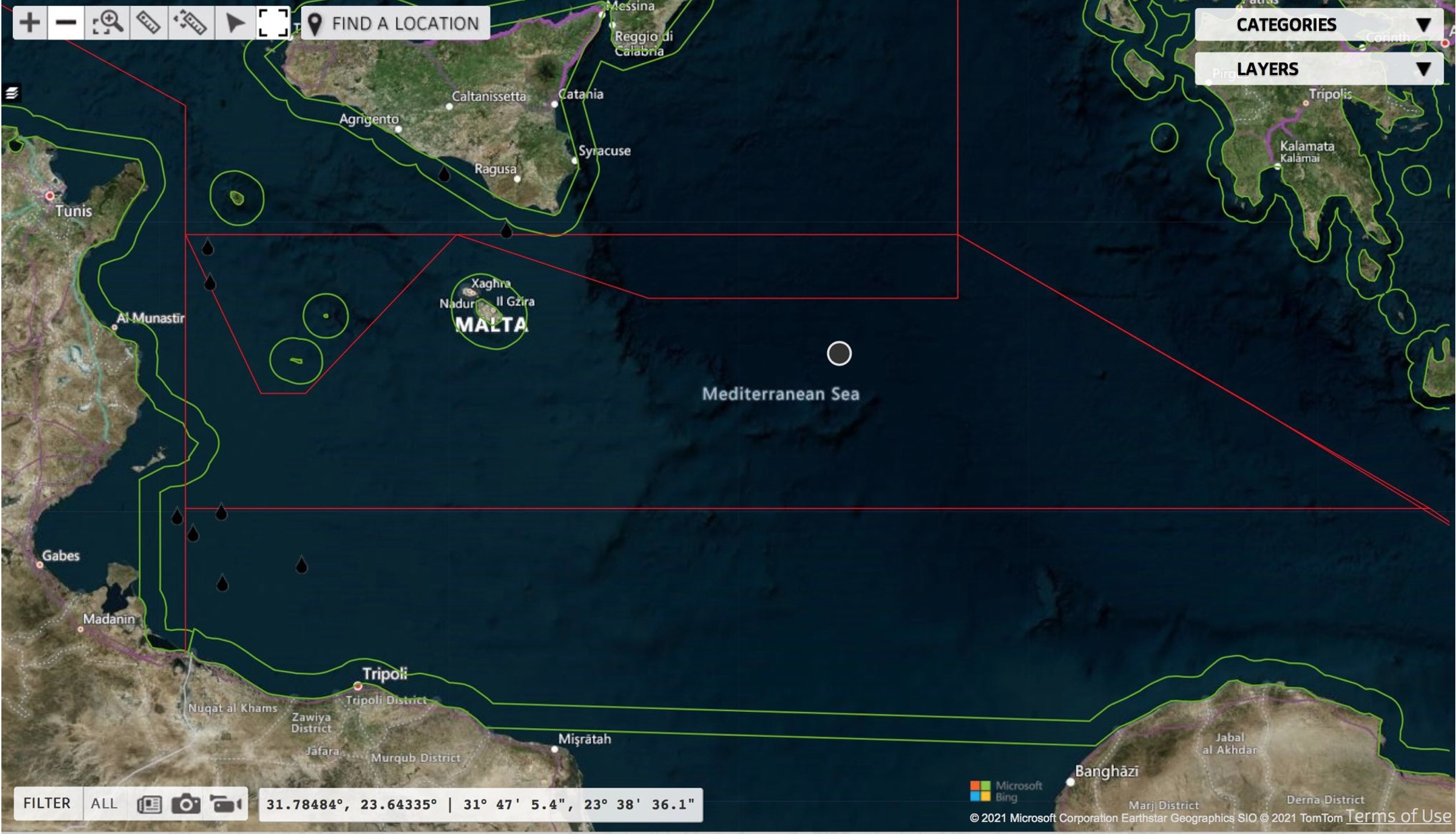 Map with the position of the boat that left from Benghazi. Source: Alarm Phone
Map with the position of the boat that left from Benghazi. Source: Alarm Phone
In the period of 31 October to 6 November, 1,085 migrants were intercepted and returned to Libya.
On 7 November, Alarm Phone was alerted by a wooden boat with over 380 people on board in the vicinity of several merchant vessels. As Seabird observed, later a Libyan ship was on scene, but fortunately, the people were able to arrive on their own in Lampedusa the following day.
On 9 November, Alarm Phone was alerted by 48 people in Maltese SAR and Seabird spotted five more boats – at least one of them was intercepted with support of Frontex. A severe storm was expected for the night and we do to know if the other boats were rescued.
On 11 November, another interception of a boat that had called Alarm Phone took place and the distressed reported that one person went missing during the journey.
On 12 November, the Geo Barents, the Sea-Eye 4 and the Nadir came back to the SAR zone.
On 14 November, the Nadir assisted already three boats (one of them had contacted Alarm Phone) – later, the Italian Coastguard took over and carried out the rescues.
The same day, media reported about the arrival of 550 people on two fishing boats in Calabria.
On 16 November, the Geo Barents rescued 62 migrants from an overcrowded boat in the Libyan SAR zone who had alerted Alarm Phone.
The same day, after a distress call from Alarm Phone, the Geo Barents rescued 99 survivors about 30 miles from the Libyan shore. At the bottom of the overcrowded wooden boat, 10 people were found dead. Survivors had spent 13 hours on the vessel trying to reach Europe.
On 19 November, Alarm Phone was alerted by 75 people in distress about 50 miles off Lampedusa. After four days at sea, they were finally rescued to the Italian island.
On 21 November, we heard from survivors that a large shipwreck had occurred four days before off Libya. Fishermen rescued 15 people, but 75 people are believed to have died.
The same day, Alarm Phone was alerted to four boats in distress in Maltese SAR. Two of them were rescued by the Italian Coastguard.
On 22 November, the Sea Watch 4 was busy with several rescues, taking 482 guests on board.
On 23 November, UNHCR helped release 58 asylum seekers from detention, but without giving them any perspective of resettlement.
On 24 November, media sources reported that one person was found dead when the Armed Forces of Malta rescued a group of 43 people.
The same day, the so-called Libyan Coastguard shot at a boat in distress in Maltese SAR zone. We lost contact to the people and the responsible EU authorities refused to share information. Only later did we learn that the 112 migrants were forced back to Libya.
On 25 November, 90 people from Libya were evacuated to Italy via a humanitarian corridor. Refugee protestors in Libya demanded from other EU countries to do the same.
On 24 and 25 November, the Alarm Phone was in constant contact with about 487 people on a boat slowly breaking apart. Still, EU authorities were doing little, merely “monitoring” the situation. UNHCR, Amnesty International and other actors demanded rescue. 24 hours after our first alert, the Tunisian navy told us that they had sent four assets and rescued the people. We emphasised once again that the boat had been in Maltese SAR zone and that Tunisia cannot be considered a port of safety.
In the period of 21-27 November, 886 migrants were intercepted and returned to Libya.
On 28 November, the Italian coastguard confirmed the rescue of about 200 people who had alerted us the day before off Calabria. Media reported a sharp increase in a new migrant route from Turkey to Calabria.
 Map with the position of the boat coming from Turkey heading toward Calabria. Source: Alarm Phone
Map with the position of the boat coming from Turkey heading toward Calabria. Source: Alarm Phone
On 30 November, the ECCHR Berlin in cooperation with human rights groups and survivors filed a criminal complaint to the International Criminal Court (ICC) on serious crimes against refugees in Libya.
December
In December, Alarm Phone was alerted to 29 boats in distress. One of them had left from Tunisia, one from Algeria and one from Turkey, the others from Libya. At least five of these boats (and many more that had not reached out to us) were intercepted by the so-called Libyan Coastguard, one by the Tunisian authorities. One boat was brought back to Libya by fishermen. Ten of these boats were rescued by four different NGO vessels, which also performed several other rescue operations. We know that four of the boats we were in contact with reached Lampedusa, as did many other boats, both from Libya and Tunisia. One of the boats we were alerted to was rescued to Calabria, another one, saved by a merchant vessel, was eventually brought to Malta. The boat from Algeria arrived in Sardegna. For some other boats, the outcome is unclear. One of our cases was a horrible shipwreck with 28 deaths and 35 people going missing, presumed dead. We also learned about several other shipwrecks off the coast of Libya in December.
On 2 December, UNHCR Libya announced the closure of the CDC (Community Day Center) in Tripoli, where thousands of migrants were carrying out their courageous protests.
On 5 December, the protesting migrants were attacked by armed guards at the UNHCR main office.
On 6 December, Refugees in Libya reacted to accusations by the UNHCR concerning violence from their side.
On 7 December, media reported that the warship “San Giorgio” arrived in Tripoli for a special mission: The Italian Navy delivered infrastructure for the maritime rescue coordination center (MRCC). Also, some border security equipment for Libya was provided by the EU.
On 15 December, the Tunisian Navy rescued 78 migrants and recovered one body from a boat that sank 20km north of Ras Jadir. The boat had departed from Libya.
On 16 December, 114 people with whom we had been in contact were rescued by the Ocean Viking. More than 100 people on two other boats were illegally pulled back to Libya – one of these boats was attacked and pursued for one hour by the so-called Libyan Coastguard.
Also on 16 December, Italy’s highest court overturned the sentence against two shipwrecked migrants accused of aiding and abetting illegal immigration, violence and resistance of a public official. The two had been rescued by the tugboat Vos Thalassa and had resisted their return to Libya. The Supreme Court stated: “The migrants rescued at sea, asserting their right to not be refouled and opposing being returned to the country of Libya, was justified in resisting a public official.”
On 17 December, a boat capsized during rescue by the authorities off the coast of Lampedusa – 25 people were rescued, one woman drowned. A shipwreck occurred a day before off Djerba. Two people died; four others went missing. Libyan fishermen rescued five migrants from a sunken boat off the coast of Sorman.
During some days of calm sea until 18 December, many people tried to flee Libya. Alarm Phone was in contact with about 600 people in distress on nine boats, four of them were rescued by the civil fleet, two were intercepted and forced back to Libya. One boat ended up in Tunisia, one boat reached Lampedusa. To one boat we lost contact.
On 21 December, two shipwrecks off Libya led to over 160 deaths. During the night, 432 people were intercepted and brought back to Libya.
On 21 and 22 December, the Geo Barents rescued several boats, also one that had alerted Alarm Phone. There were also several arrivals in Lampedusa.
On 23 December, three NGO ships were awaiting a port of safety: the Geo Barents with 358 guests on board, the Ocean Viking with 114 people and the SeaEye with 216 people. On the day, Alarm Phone was alerted by several boats in distress, but authorities failed to react.
On 24 December, the militia leader Mohammed al-Khoja (notorious for abuse against migrants in Sika Detention Center) was nominated head of DCIM – the agency responsible for detention centers under the Ministry of Interior. Al-Khoja has gained legitimacy thanks to the European Commission.
On 25 December, 42 hours after our first alert about 27 people in distress in Maltese SAR, the Italian Coastguard reacted and searched for them. Only one day later, they found and rescued the 27 migrants on the Crotone coast.
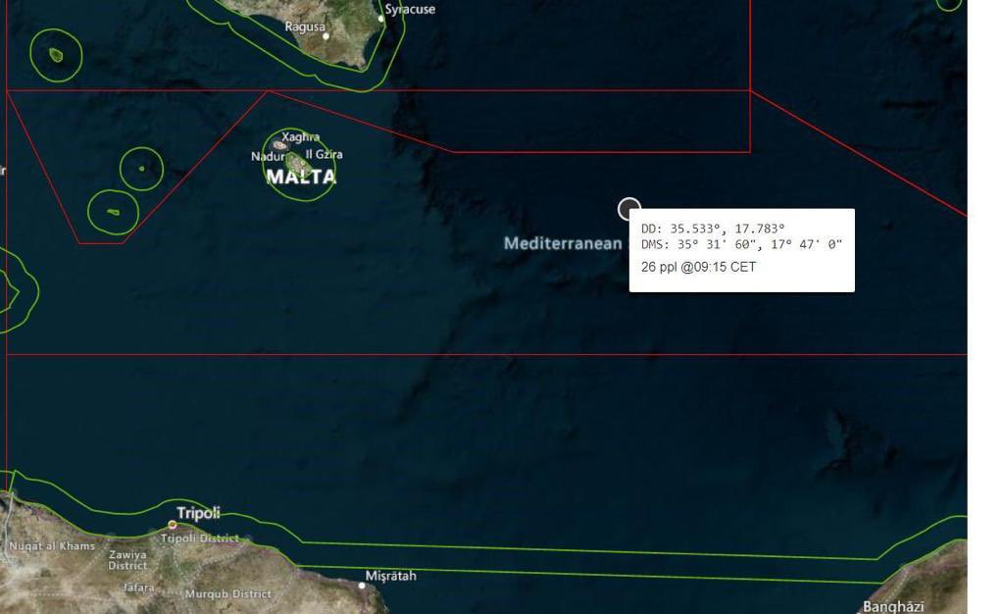 Map with the position of the boat that called us on 25 December. Source: Alarm Phone
Map with the position of the boat that called us on 25 December. Source: Alarm Phone
The same day, we were in contact with 108 people in the Ionian Sea who reported that their boat was breaking apart. After many hours of uncertainty, we learned that the people had arrived in Italy.
On 26 December, Alarm Phone was called by a boat carrying 30 people who had left from Benghazi area 5 days earlier. On 28 December, after being ignored for 38 hours at sea, the boat was finally spotted by a Sea Watch plane. Thanks to the intervention of the merchant vessel PanUnity, the people were rescued. Later they were transfered to an AFM vessel.
At the end of the year, the Geo Barents and the Sea Watch 3 were finally assigned a place of safety at Sicilian ports.